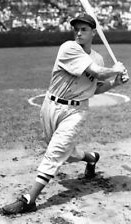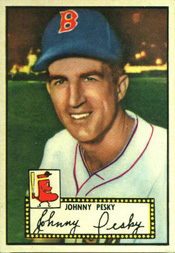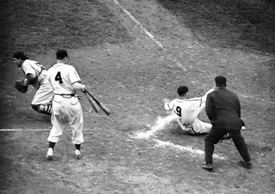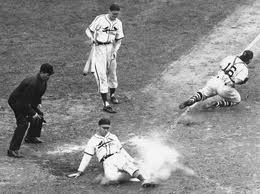|
Pivotal World Series Plays
Slaughter's Mad Dash
1946 World Series Game 7: Boston Red Sox @ St. Louis Cardinals
The Boston Red Sox have just scored two runs in the top of the eighth to tie the St. Louis Cardinals 3-3. Boston manager Joe Cronin must make two changes in his lineup for the bottom of the inning. CF Dom DiMaggio popped a hamstring while running out a double in the top of the inning that drove in the tying run. He was replaced on the base paths by Leon Culberson, who was stranded at second when LF Ted Williams, with a chance to drive in the go-ahead run, popped out.
Cronin brings in 38-year-old righthander Bob Klinger to pitch. Decades later, when saves were retroactively computed, it was found that Klinger led the '46 Red Sox with nine. He had a 3-2 record and 2.37 ERA. But he has not pitched in a "real" game since September 19 because of an illness in his family.
Cronin later explained that he wanted to pitch Klinger in the eighth, pinch-hit for him in the the top of the ninth, and have Tex Hughson available for the bottom of the inning.
Cardinal RF Enos "Country" Slaughter starts the proceedings by slapping a single into center field. With none out, Cardinal manager Eddie Dyer chooses not to have Enos steal but instead gives the bunt sign to 3B Whitey Kurowski. But his attempted sacrifice results in a popup to Klinger.
C Del Rice then lofts a long fly that Williams lopes back and catches.
With left-handed hitting LF Harry "The Hat" Walker up next, surely Cronin will now play the percentages and bring in southpaw Earl Johnson, who is throwing in the bullpen. But Joe sticks with Klinger, a decision that will bring him widespread criticism in the days to come.
After two years of military service, Walker has endured his worst season in the majors. He hit only .237 and drove in just 27 runs although he has hit better in the Series: 6-for-21 (.286). Like Williams in the top of the inning, Walker has a chance to be a hero as he steps to the plate for one of the most famous at-bats in baseball history.
CF Culberson has average speed and an average throwing arm. The man he replaced, Dom DiMaggio, was arguably the most aggressive center fielder of his era who took pride in positioning himself properly for each hitter. Dom got a good jump on balls hit his way and charged hard and fast after the ones he couldn't catch to keep the batter and any runners from taking an extra base. Some observers rate him a better center fielder than his older brother Joe.
Another factor is the condition of the field, the worst the Red Sox have ever played on. With the Cardinals and the Browns sharing Sportsman's Park, the grass took a beating over 154 games. The turf is torn up and rock solid. After eight games against the Browns and four World Series contests that season, Dom knew the center field area well. But Culberson hasn't played center field in St. Louis since a three-game series in mid-June when DiMaggio was hurt. Leon will chase balls more tentatively lest he stumble or misplay a hop. Dying inside while sitting on the bench with his leg propped up, Dom tries to help as best he can. As Walker strides to the plate, DiMaggio notices that Culberson is playing him a little toward right field. So Dom waves to move Culberson to his right - toward left-center field. Leon moves a few feet but not as much as Dom wants. He either doesn't see or ignores Dom's frantic signal to shift over more.    L-R: Dom DiMaggio, Bob Klinger, Harry Walker, Johnny Pesky With two outs and Klinger not holding him well, Country decides to steal second to get into scoring position. As soon as Bob commits himself to throw the first pitch home, Enos takes off, but Walker fouls it off. To give C Roy Pardee a better chance to throw out Slaughter, Klinger throws two straight fastballs out of the strike zone. But Country makes no move. With the count 2-1, Dyer signals for a hit-and-run. When Enos takes off with the pitch, SS Johnny Pesky starts toward second to take a possible throw from the catcher. But Walker swings and loops a hit into left-center field, a "dying seagull" as Harry later described it. Johnny immediately reverses course and runs to short left field to take a relay throw. As soon as Slaughter sees that the ball will land safely and knowing that Culberson is in center field and not DiMaggio, Enos decides he can make it home. "I knew I was going to score even before I hit second base," he tells sportswriter Bob Broeg after the game.
A play earlier in the Series stuck in Slaughter's craw and made him even more aggressive than usual, if that's possible.
With two outs and none on in the 4th inning of Game One, he poled a ball to the left-center field wall. Roaring around the bases, he was ready to try for an inside-the-park homer. But 3B Coach Mike Gonzalez threw up a stop sign. Kurowski flied out to end the inning, and the Cards lost by a run in 10 innings. Never one to suffer in silence, Slaughter bitched to Dyer until the manager gave him the right to go on his own. "From now on, if you think you have a legitimate chance to score, I'll take the blame," Eddie told him.
Wary of bad hops on the uneven outfield turf, Culberson takes a more roundabout path to the ball to make sure it doesn't bounce away from him. He is thinking only of holding Slaughter at third and Walker at first.
Red Sox 2B Bobby Doerr later said of Culberson, "He was a little too cautious." But he added, "I don't blame him. That ballpark was terrible. They put in a new turf for the Series, and in practice a ball went right under the grass. I actually had to reach under the grass to get the ball. That's how poorly the field was kept. Certainly the outfield wasn't smooth during game seven."
Leon fields the ball cleanly at a point almost in a direct line from home plate through the normal shortstop position. Assuming Slaughter will stop at third, Culberson throws the ball to Pesky, who receivesit at the back edge of the infield dirt. Johnny has his back to the plate and, as he admits afterward, also doesn't think Slaughter will try to score. Several accounts say that third base coach Mike Gonzalez is signaling for Enos to stop at third. On the video, Gonzalez comes into the picture only when Country is reaching the bag. All Mike is trying to do at that point is get out of his runner's way. Slaughter misses him by 2' or less but doesn't break stride.
One account says Gonzalez yelled "No, no!" but Enos thought he said, "Go, go!" It wouldn't have made any difference what Mike said or did. Slaughter was determined to score. "I made up my mind when I started running from first base ... that I was going all the way around. When I was tearing into third, Mike Gonzalez was giving me the high ball, but I was going anyway. I was determined to make them throw me out at the plate."
With the crowd roaring, Pesky doesn't hear his teammates yelling "Home!" So when he turns, he hesitates a moment, dropping his hands. Then seeing Slaughter with head down digging hard several steps past third, the shortstop uncorks an off-balance throw that sails 10' up the third base line. Enos slows slightly to avoid the next hitter, Marion, who has retrieved Walker's bat and is standing just outside the basepath near the plate. The Cardinal right fielder ends the most famous piece of baserunning in World Series history by sliding easily across with the go-ahead run.
Pesky might have had a chance to nail Country if he had turned immediately and fired the ball on the fly to Partee at the plate. But even then, the throw might have arrived too late. And Slaughter wouldn't have hesitated to bowl over Partee to make him drop the ball.
Walker was credited with a double although some observers thought he went to second on the throw-in. Many still describe the play as "Slaughter scored from first on a single." However, footage of the play shows Harry arriving at second about the time Slaughter slid home.
A possibility that no one has mentioned over the decades is that Pesky might have tried to get the third out at second base before Country crossed the plate. Doerr stood on the bag and could have put the tag on Walker. In fact, Harry later admitted he went to second to try to draw a throw and enable Slaughter to score. That's why he defended the scorers giving him a double. But no Red Sox player seems to have thought about Walker. Doerr was yelling "Home!" like all his teammates. Also, Harry would probably have gotten himself caught in a rundown if necessary to make sure Slaughter's run counted.
Years later, Enos told Tim McCarver: "Pesky got blamed for hesitating before throwing home, but I blame their second baseman, Bobby Doerr, and third baseman, Pinky Higgins, for not letting Pesky know where to throw the ball when his back was turned." Decades later, Pesky said: "I don't even want to talk about that. I got blamed for something I didn't think was my fault. It always comes up. About three weeks ago, I was in the market, and a guy climbed all over me. 'You're a bum.' ... I said, 'You want to blame me, go ahead.' It's one of those things I've had to live with. ... The (radio) announcer, Arch McDonald, said that I took too long to get rid of the ball, that I hesitated and all that. ... To this day, I feel we had a better ballclub than the Cardinals. They had one guy who was outstanding in the Series, Harry Brecheen, and we didn't win. It's a sad thing when you think you should have won, and you don't."
Despite the crowd's frenzy, the game wasn't over. Since he couldn't let the Cards get an insurance run, Cronin had Klinger purposely pass SS Marty Marion. Then Joe finally brought in Johnson to face P Harry Brecheen, who had come in from the bullpen in the top of the eighth. In the other dugout, Dyer decided he'd rather have Harry on the mound for the ninth than an insurance run. So The Cat hit for himself and grounded to second.
  Slaughter avoids Marion and slides home with go-ahead run. Far be it from this exciting series to end quietly. Cardinal fans were confident with Brecheen on the mound because "The Cat" had won games two and six as a starter. But the Red Sox got the tying run to third with only one out. But the little lefty got the next two batters on a popup and ground out to join a select group of pitchers who have won three games in a single World Series.
Read the article on the entire 7th game of the 1946 World Series .... |